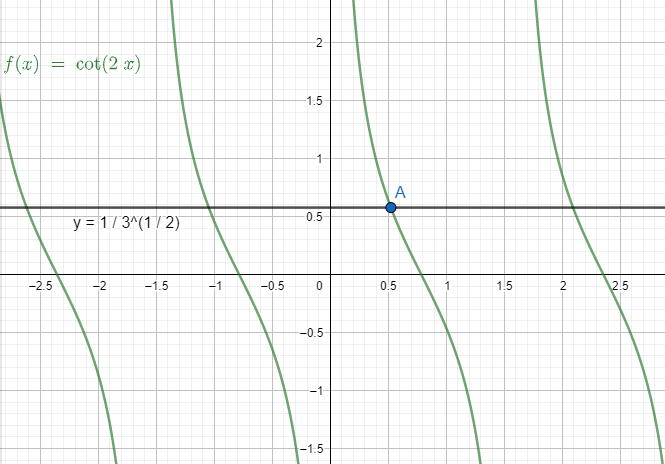
How do you solve $3\cot 2x-\sqrt{3}=0$?
Answer
538.2k+ views
Hint: We first simplify the equation $3\cot 2x-\sqrt{3}=0$ to find the value of $\cot 2x$. Then we find the principal value of x for which $3\cot 2x-\sqrt{3}=0$. In that domain, equal value of the same ratio gives equal angles. We find the angle value for x. At the end we also find the general solution for the equation $3\cot 2x-\sqrt{3}=0$.
Complete step-by-step solution:
It’s given that $3\cot 2x-\sqrt{3}=0$. We simplify the equation to get
$\begin{align}
& 3\cot 2x-\sqrt{3}=0 \\
& \Rightarrow \cot 2x=\dfrac{\sqrt{3}}{3}=\dfrac{1}{\sqrt{3}} \\
\end{align}$
The value in fraction is $\dfrac{1}{\sqrt{3}}$. We need to find x for which $\cot 2x=\dfrac{1}{\sqrt{3}}$.
We know that in the principal domain or the periodic value of $0\le x\le \pi $ for $\sin x$, if we get $\cot a=\cot b$ where $0\le a,b\le \pi $ then $a=b$.
We have the value of $\cot \left( \dfrac{\pi }{3} \right)$ as $\dfrac{1}{\sqrt{3}}$. $0<\dfrac{\pi }{3}<\pi $.
Therefore, $\cot \left( 2x \right)=\dfrac{1}{\sqrt{3}}=\cot \left( \dfrac{\pi }{3} \right)$ which gives $2x=\dfrac{\pi }{3}$.
For $\cot \left( 2x \right)=\dfrac{1}{\sqrt{3}}$, the value of x is $x=\dfrac{\pi }{6}$.
We also can show the solutions (primary and general) of the equation $\cot \left( 2x \right)=\dfrac{1}{\sqrt{3}}$ through the graph. We take $y=\cot \left( 2x \right)=\dfrac{1}{\sqrt{3}}$. We got two equations $y=\cot \left( 2x \right)$ and $y=\dfrac{1}{\sqrt{3}}$. We place them on the graph and find the solutions as their intersecting points.

We can see the primary solution in the interval $0\le x\le \pi $ is the point A as $x=\dfrac{\pi }{6}$.
All the other intersecting points of the curve and the line are general solutions.
Note: Although for elementary knowledge the principal domain is enough to solve the problem. But if mentioned to find the general solution then the domain changes to $0\le x\le \pi $. In that case we have to use the formula $x=n\pi +a$ for $\cot \left( x \right)=\cot a$ where $0\le a\le \pi $. For our given problem $\cot \left( 2x \right)=\dfrac{1}{\sqrt{3}}$, the general solution will be $2x=n\pi +\dfrac{\pi }{3}$. Here $n\in \mathbb{Z}$.
The simplified form of the general solution will be \[x=\dfrac{n\pi }{2}+\dfrac{\pi }{6}\].
Complete step-by-step solution:
It’s given that $3\cot 2x-\sqrt{3}=0$. We simplify the equation to get
$\begin{align}
& 3\cot 2x-\sqrt{3}=0 \\
& \Rightarrow \cot 2x=\dfrac{\sqrt{3}}{3}=\dfrac{1}{\sqrt{3}} \\
\end{align}$
The value in fraction is $\dfrac{1}{\sqrt{3}}$. We need to find x for which $\cot 2x=\dfrac{1}{\sqrt{3}}$.
We know that in the principal domain or the periodic value of $0\le x\le \pi $ for $\sin x$, if we get $\cot a=\cot b$ where $0\le a,b\le \pi $ then $a=b$.
We have the value of $\cot \left( \dfrac{\pi }{3} \right)$ as $\dfrac{1}{\sqrt{3}}$. $0<\dfrac{\pi }{3}<\pi $.
Therefore, $\cot \left( 2x \right)=\dfrac{1}{\sqrt{3}}=\cot \left( \dfrac{\pi }{3} \right)$ which gives $2x=\dfrac{\pi }{3}$.
For $\cot \left( 2x \right)=\dfrac{1}{\sqrt{3}}$, the value of x is $x=\dfrac{\pi }{6}$.
We also can show the solutions (primary and general) of the equation $\cot \left( 2x \right)=\dfrac{1}{\sqrt{3}}$ through the graph. We take $y=\cot \left( 2x \right)=\dfrac{1}{\sqrt{3}}$. We got two equations $y=\cot \left( 2x \right)$ and $y=\dfrac{1}{\sqrt{3}}$. We place them on the graph and find the solutions as their intersecting points.

We can see the primary solution in the interval $0\le x\le \pi $ is the point A as $x=\dfrac{\pi }{6}$.
All the other intersecting points of the curve and the line are general solutions.
Note: Although for elementary knowledge the principal domain is enough to solve the problem. But if mentioned to find the general solution then the domain changes to $0\le x\le \pi $. In that case we have to use the formula $x=n\pi +a$ for $\cot \left( x \right)=\cot a$ where $0\le a\le \pi $. For our given problem $\cot \left( 2x \right)=\dfrac{1}{\sqrt{3}}$, the general solution will be $2x=n\pi +\dfrac{\pi }{3}$. Here $n\in \mathbb{Z}$.
The simplified form of the general solution will be \[x=\dfrac{n\pi }{2}+\dfrac{\pi }{6}\].
Recently Updated Pages
Why are manures considered better than fertilizers class 11 biology CBSE

Find the coordinates of the midpoint of the line segment class 11 maths CBSE

Distinguish between static friction limiting friction class 11 physics CBSE

The Chairman of the constituent Assembly was A Jawaharlal class 11 social science CBSE

The first National Commission on Labour NCL submitted class 11 social science CBSE

Number of all subshell of n + l 7 is A 4 B 5 C 6 D class 11 chemistry CBSE

Trending doubts
What is meant by exothermic and endothermic reactions class 11 chemistry CBSE

10 examples of friction in our daily life

One Metric ton is equal to kg A 10000 B 1000 C 100 class 11 physics CBSE

1 Quintal is equal to a 110 kg b 10 kg c 100kg d 1000 class 11 physics CBSE

Difference Between Prokaryotic Cells and Eukaryotic Cells

What are Quantum numbers Explain the quantum number class 11 chemistry CBSE




